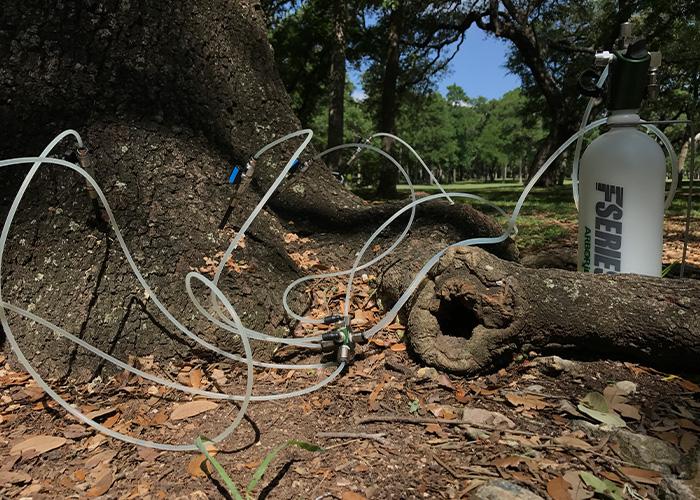Oak Wilt is a devastating vascular wilt disease that commonly affects all oaks, but most commonly species in the red oak family. It has been confirmed in over 20 states. Oak Wilt spreads rapidly through the tree’s vascular system and can kill susceptible untreated trees in a matter of weeks. Once it’s been confirmed in an area, it is most often transmitted through underground root grafts between neighboring trees and beetles. Preventative treatments are considered the most effective, since tree recovery is proportional to infection severity. When an oak wilt infection is confirmed, treatment can be applied to the surrounding trees to prevent further spread of this disease.
Signs of Oak Wilt
The first sign of oak wilt is leaf die back and defoliation. If you suspect Oak Wilt, get a branch sample and look for staining. Visible signs include bark cracking, indicating there can be black or gray fungal mats forming underneath. Oak Wilt needs to be confirmed to make sure there isn’t another problem affecting the tree. When in doubt, contact your local extension agency. Laboratory tests and fungal culturing on agar media can be used to confirm the pathogen’s presence. For red oaks, symptoms are shown in the spring and can continue into the summer. Symptoms will start from the outer leaf and move toward the stem. The leaves will start to turn a dull green or bronze and then turn to yellow or brown. As the disease progresses, limbs will die off. However, treatment will help prevent the disease from spreading.
Prevention
Prevention is the key to success. To prevent Oak Wilt, do not prune trees during the warm season, which can vary by state. If you must make a cut and there is a spore, make sure to using a pruning seal to prevent the spread. If you have oaks on your property, hire a qualified arborist to help monitor and manage your tree to prevent the disease. This may involve separation of a root graft. Contact your local extension agent to find out when removal is your best option.
Treatment
We recommend treatment by trunk injection of Propizol. Propiconazole is a systemic fungicide that will suppress Bretiziella fagacearum. Because Oak Wilt is spread through root grafts and insect carriers, we recommend the treatment of non-infected oaks near the infected trees to slow the spread of the disease. Trees within 30 feet of a positive infection are at a great risk of root graft infection. Generally, the best seasons for injection are the fall and spring. For trunk injections ,soil temperature should be above 40° F. If treating a tree in the summer, inject in the morning for a quick uptake.

After Treatment
Trunk injection of propiconazole will suppress the fungus (Bretiziella fagacearum). Residues of the chemistry will persist in the tree for approximately one to two years. Trees should be re-evaluated for retreatment every 12-24 months.
Connect with your Arborjet Regional Technical Manager to discuss the best method for you.

